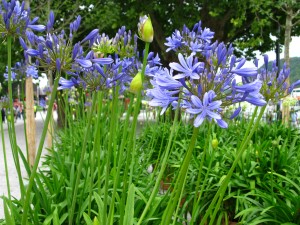Lily-of-the-Nile (Agapanthus praecox orientalis) is native to South Africa (USDA Zones 8–11), and is not reliably hardy in the Southern Appalachian region (USDA zone 6 and 7). However, many gardeners are successfully growing it as a “tender perennial”. Agapanthus grows in an outdoor flower bed or in a container.
The ball shaped light blue or white tubular shaped flower clusters first appear in late spring and early summer. By promptly deadheading spent flowers, agapanthus may produce another 1-2 flushes in summer and early fall.
Agapanthus grows 2-3 feet in height and 1 ½ -2 feet in spread with dense tuft of 1 inch wide strap-like dark green leaves which measure a foot or more in length. It prefers a compost rich soil (media), constant moisture and partial sunlight. Weekly watering promotes a deep, extensive root system.
During the winter months lay a thick 3 inches of organic mulch over the crown to protect the roots from frost. Remove the mulch once warm spring weather returns.
Container-grown plants should be cut back and brought indoors by early November and nurtured as house plants through the winter. Divide crowded root clumps every 2 to 3 years in early spring.
If you garden further north (USDA zone 5) tender agapanthus should be dug up and stored inside for the winter. Allow plant(s) to thoroughly dry out and trim back the foliage. Keep the dormant crown in a cool, dark location for the winter between 35 – 40ºF. In late winter move the dormant corms into a warm area and moisten the soil to force new growth. Bring plants back outdoors in mid-May to enjoy another summer in the garden.
Mealy bug and red spider mite can be major pest problems.


 Posted in
Posted in 
